Santa Fe wasn’t always on the proverbial map — in fact, the Santa Fe railroad just passed it on by. A lot of care has been taken to keep Santa Fe cute and quaint over its history, with steps to preserve native architecture and historical design. The result is a mixture of structures old and new, but mostly made to look old, for better or worse.
This week, Roman Mars takes us on a tour of Santa Fe’s built environment, with its many quirks and strange stories, starting with a history of the city, and how it evolved its unique architectural style. Note: this series is made possible by the all-new 2024 Lexus GX and SiriusXM who heard this idea, gave no notes, and said just go make something cool.
Early builders in the region didn’t have much access to tin or wood or rock; what they had in great abundance was dirt and clay, which they used to make adobe bricks that were then stacked and stucco’d. (In fact, we have a whole episode about the aesthetics that evolved from these necessities and other factors, linked above!). Some of the designs Roman talks about in this episode are listed below:
Vigas: In part, the scale of the city was limited by material constraints of the region — the availability of trees, for instance, and difficulty of transporting logs and other materials to the area.
 “Vigas” are a region-specific sort of beam that emerged out of the unique combination of constraints and opportunities afforded local builders.
“Vigas” are a region-specific sort of beam that emerged out of the unique combination of constraints and opportunities afforded local builders.
The Acequia Madre is a very very old irrigation ditch, built 400+ years ago. This acequia still runs through one of Santa Fe’s oldest neighborhoods, along a street with the same name “Acequia Madre.” Acequias are a cool part of NM culture, and are very much a kind of design most would overlook but with deep history
The Loretto Chapel has a mysterious magic staircase:
“The stairway’s carpenter, whoever he was, built a magnificent structure. The design was innovative for the time and some of the design considerations still perplex experts today. The staircase has two 360 degree turns and no visible means of support.” It is said that the staircase was built without nails—only wooden pegs. Questions also surround the number of stair risers relative to the height of the choir loft and about the types of wood and other materials used in the stairway’s construction. The staircase still begs to be solved, even now — it has been the subject of many articles, TV specials, and movies including “Unsolved Mysteries” and the full-length movie titled “The Staircase”, starring William Petersen and Barbara Hershey.
Stay tuned for the final episode in this series as Roman travels to Athens, Georgia!
You can stream your first 3 months of SiriusXM free on the new SiriusXM app, where you can listen online or on other compatible devices. You’ll get more than 425 channels including ad-free music, plus sports, news, comedy, and more. Offer Details apply. Subscribe today.









Leave a Comment
Share